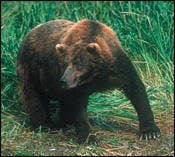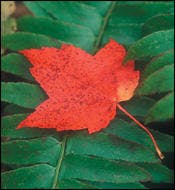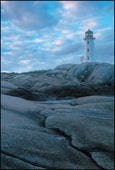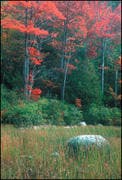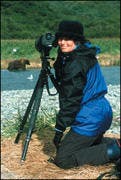Kodiak moments
This Washington hygienist travels far and wide to capture the moment.
by Rod Barbee
Photo by Tracy Rowley
Until she actually saw it happening, the sound of bones being crushed was just part of the background sounds of sea gulls, wind, and water. Looking through the viewfinder of her camera while a bear devoured yet another salmon and hearing the sound of that salmon begin its final journey, she felt the immediacy of her surroundings even more. Not 40 feet away, in the middle of a stream, stood the top of the food chain, the Alaska brown bear.
When Tracy Rowley, a hygienist from Washington, discovered an interest in nature photography, the last thing she expected was a close encounter with the largest carnivore in North America. But less than a year after first picking up a camera, she journeyed to the wilderness coast of Alaska to photograph the large coastal grizzly bears.
This was her first experience being so close to a wild creature that, if it chose to, could end her life. Surprisingly, she felt little anxiety, being more concerned with lighting, shutter speed, focusing, and trying to remember all of the things she had learned about photography.
Photo by Tracy Rowley
Rowley, 42, has been a hygienist for 13 years. She graduated in 1989 from the University of Louisville School of Dentistry, though she's been in the dental profession for nearly 23 years. She currently works for three dental practices, and enjoys the variety of the different offices. "I love being a hygienist, and the rewards the profession provides are irreplaceable," she says. "But sometimes I need a break from the physical demands of the job. Photography has helped me get back to nature, and the trips we take are a great way to rest and recharge."
It's not all rest, though. Most trips involve getting up early to see the sunrise and staying out late for sunset, especially in the summer months. And then there's all that camera gear. "We often need to do some hiking to get to our destination, and it can get tiring carrying all that gear and a tripod. We've had to sleep on the ground, in a boat, in the car. It's not all bad; I love to go camping, and, since meeting my husband, I've gone backpacking for the first time too. So far we've been rained on during every trip, and I've fallen in two streams. But I've also seen a herd of elk in the wilderness, and there's nothing like sitting next to a river in the sunshine after being stuck in a tent all day."
Tracy's interest in nature photography was sparked one afternoon while watching a storm from her former home on Mercer Island, near Seattle, Wash. "The sun broke through with a beam of the most beautiful light. It was an amazing moment. I wanted to capture moments like that, both the light and the emotion I felt."
She did some research, bought a camera, and enrolled in a photo course presented by the Mountaineers in Seattle. That's also where she met her husband, who was one of the instructors and a professional photographer. Ever since, she's been photographing whenever possible.
She also accompanies her husband on some of his trips, including the bear trip to Alaska, when her work schedule allows. "I'd have to say the bear trip was the most memorable yet. While I was looking through the viewfinder, the bears were the only things I was aware of. It was both frightening and exciting to be so close. We were in their world; there was no protection whatsoever around us, just us and the bears. Fortunately, they were more interested in salmon than they were in us."
To be sure, not all moments are exciting ones. Nature photography isn't just about being in the right place at the right time; it's also about getting to those places. Trips to both Alaska and Nova Scotia involved open ocean crossings, and seasickness was an unwelcome companion. "During the crossing to Nova Scotia, it seemed that half of the passengers were sick, which was definitely not much fun," she says. "At least in Alaska, the trips between Kodiak Island and the mainland were at night, and I was able to sleep through most of it."
In addition to the Alaska and Nova Scotia trips, Tracy and her husband also have photographed in several national parks as well as taken a trip to Vermont for the fall color.
"The frustrating thing about nature photography is that you're depending on nature," she says. "There was an early freeze in Vermont, and we arrived about a week too late for the prime fall color and had to do some searching. We found some of the best color in a cemetery, of all places."
Photo by Tracy Rowley
A trip to Glacier National Park was memorable for the picture she didn't get. The plan for one morning was to photograph the peaks at sunrise and then have breakfast at the nearby Many Glacier Hotel. Even in the middle of July, the mornings can be cold. While waiting on the windy shores of Swiftcurrent Lake for the sun to break through the clouds and light up the peaks, Tracy decided that it was too cold and that the light wasn't going to happen anyway. "I had been told how great the breakfast was at the hotel, and I guess my mind was on warmth and waffles more than on photography. I gave up waiting for the light and put my gear away. My husband, being a professional, waited it out. He ended up with some very dramatic shots while I tried to stay warm. I've learned that sometimes you have to sacrifice comfort to get great pictures."
And the breakfast? "It was great! Waffles, pancakes, juice, sausage, fresh fruit; anything you could ever want. And the view was spectacular."
Since taking up photography, she's also made some major changes in her life, including a move to Washington's Olympic peninsula and getting married. "When I began photographing, one of my goals was to surround myself with beauty, and I've been able to do that in ways I never could have imagined." She's also come to better appreciate the aesthetics of photography and what goes into creating a good picture. "Photography is not as easy as it seems," she explains. "There are so many little things that go into making a good picture that I never knew about before. People will look at my husband's work and comment about how their pictures never turn out that good. They don't realize how much work it can be to get those great shots."
Photo by Tracy Rowley
While photographing, Tracy enjoys taking close-up pictures of leaves and flowers. She finds that wildlife photography, even though it's more difficult, can be addictive. "There's something about being so close to a wild animal; there's a connection that you feel. Unfortunately, the equipment needed is expensive and heavy. Both my husband and I use Nikon cameras, so he carries the gear and I get to use it," she says with a grin.
For aspiring photographers, she recommends joining a photo club and learning from others. She also advises patience. "I'm still learning about metering, exposure, which lens to use, and working with a tripod. It can get frustrating when I think I have a great shot, only to find out I blew it. But I keep at it, because I'm still trying to capture that light and it's so fulfilling just being outside photographing."
Her husband also travels around the United States for a photo workshop and tour company. As her work schedule allows, Tracy enjoys accompanying him. A commonality she's discovered is the prevalence of dental professionals who are also photographers. "On every workshop I've attended so far, there's been a dentist or an orthodontist there. It's been great running into others in the profession and having something in common besides dentistry. They usually have the best camera equipment too!"
Future plans include taking more photo trips with her husband (Africa and Europe are on the agenda) and also helping to market and promote his work. "I have a lot to learn about the business of photography if I want to help out. Taking the pictures seems to be the easiest part," she says.
Photo by Rod Barbee
While photography is not her main passion in life, it's certainly has its rewards. Despite having to get up early at times, sleep on the ground, or deal with unpleasant weather conditions, the satisfaction of creating a good photograph, her own work of art, keeps her coming back for more. Often, it isn't even the end result, but, rather, the process that holds the reward. Nature photography has opened a door for Tracy to a connection with the natural world that otherwise might not have been found.
"Photography has gotten me out to new places. I've also become more interested in birds. And I notice more. I see things I didn't see before, things right at my feet. I pay more attention to the world around me. I love photographing animals; there's something about seeing a wild animal through the viewfinder that is very exciting, and, despite being scared at times, I'd definitely go back to Alaska to photograph the bears again." She adds, "I also found my husband through photography, so there are definitely side benefits!"
Rod Barbee is a freelance nature photographer with publishing credits that include Outdoor Photographer magazine, Nature's Best magazine, Northwest Travel magazine and calendar, Backpacker magazine, Nature Photographer magazine, the National Park Service, and National Parks magazine. His photos have been published as greeting cards and also have been used in books. Several of his images appear in the Amphoto book, American Vision. In addition, his pictures have been used in catalogs and as part of official artwork for a Northwest regional photographic exhibition. Rod teaches nature photography through a local community college and the Mountaineers in Seattle. In addition, he is on staff with Great American Photography Weekend workshops, a photo workshop/tour company. The natural beauty discovered during backpacking trips into Olympic National Park led him to nature photography. It has since become a passion in his life from which he continues to learn and grow. Rod lives in Port Ludlow on Washington's Olympic peninsula.

